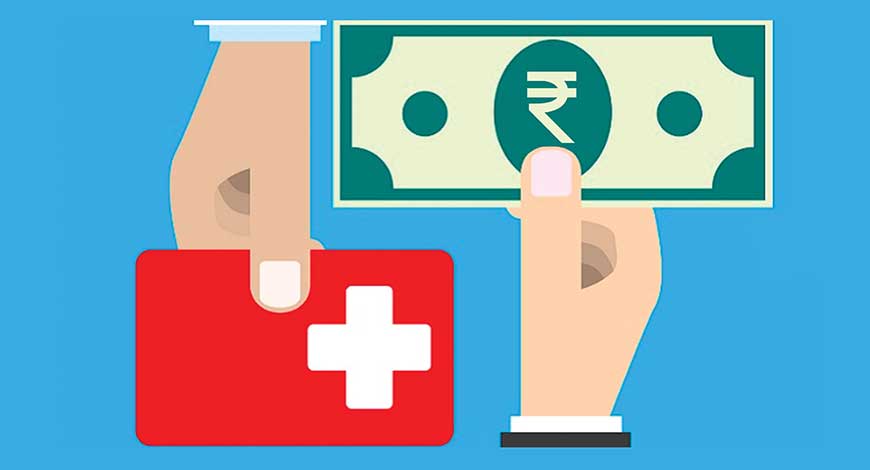MB Stories
Is price fixing the answer to tackling rising medical inflation?

The CGHS rates, if imposed by the apex court, is likely a temporary measure. It wants the government to come back with its own set of rates.
The Supreme Court, prompted by a public interest litigation filed by an NGO, Veterans Forum for Transparency in Public Life, has shown concern over the wide variation in treatment costs between government and private healthcare centers.
Under this, all hospitals and clinical establishments must display rates charged for each type of service provided and facilities available for the benefit of patients at a conspicuous place in the vernacular as well as in the English language; and charge rates for each type of procedure and service within the range of rates determined and issued by the Center from time to time, in consultation with state governments. According to the rules, this must be done for hospitals and clinics to keep their registrations valid. If the union government fails to find a solution, then we will consider the petitioner’s plea for implementing Central Government Health Scheme (CGHS)-prescribed standardized rates, the court warned the Center on February 27.
The Center is expected to expeditiously fix treatment charges to be paid by patients. The apex court wants the government to introduce price controls across hospitals in India. It wants all the hospitals to list their predetermined price bands for medical treatments and to ensure uniformity all over the country. It has also directed the Center to expeditiously fix treatment charges to be paid by patients.
The Supreme Court suggested the union health secretary meet with his state counterparts to set the price range, ending the disparity in rates and ensuring notification of a standard rate within a month. The Supreme Court has set a six-week deadline ending April 11 for the union health ministry to hold meetings with the states and union territories and come up with a concrete proposal.
The consultation of the union health secretary with his counterparts in states or union territories on capping prices of health treatments has not yet started. The health ministry is currently examining the roadblocks to fixing treatment charges at healthcare centers.
The ministry believes having one price across the nation might be difficult, as treatment costs depend on several factors. It is tough to ensure adherence to the price cap across hospital chains. Also, health is a state subject. A pan Indian implementation may warrant a change in legislation. This is because only 12 states and seven Union territories (UTs) have adopted the Clinical Establishment Act, 2010. The Center can direct the states only to some extent. The prices can likely be capped by the states, and by procedure.
Meanwhile, the Indian government is preparing a ready reckoner to note the views of hospitals, states or union territories, the Insurance Regulatory and Development Authority of India (IRDAI), and other stakeholders.
The Center has formed a high-level panel. The committee is chaired by the secretary, department of pharmaceuticals (DoP); with chairman, National Pharmaceutical Pricing Authority (NPPA); and the economic adviser to the DoP among its core members. Representatives from two major pharmaceutical organizations, Indian Pharmaceutical Alliance (IPA) and Indian Drug Manufacturers Association (IDMA), have also been included in the panel as special invitees.
The terms of reference for the panel include institutional reforms within the NPPA and how to balance price and availability of essential medicines, while providing incentives to the industry to sustain growth and exports. Also, the panel will suggest a price moderation framework for medical devices, while providing incentives to the industry to sustain growth and minimize imports, and for emerging and precision therapies to facilitate their timely reach to needy patients. The panel needs to submit its report within the next three months.
The debate among the various stakeholders is heating up
Private hospitals say the move will be catastrophic for the industry. The difference between CGHS and private hospital rates can range from 20 percent to 60 percent. Standardization of rates for different medical procedures is difficult to implement as it is dependent on factors, such as complexity of cases, level of technology, and equipment used along with the doctor’s experience. Cost varies with location, minimum wages, the kind of infection control policy, which is adopted by the hospital, patient safety measures, IT services, etc. Price for a big hospital and a small clinic cannot be standardized.
Also, even within the clinical setup, a top-of-the-line hospital, with the most experienced doctors and the latest in operation technology, will face higher costs than a smaller clinic. They will have to charge higher for their medical procedures to recoup those costs. This could end up with a wide range of rates.
This will impact investments too. Over the past four years, investment in health companies has increased 15 times to ₹30,000 crore, leading to a steep run-up in the valuation of companies in the sector and their stock prices. The companies have also undertaken huge capital expenditure (CapEx) over the last few years to upgrade capacity and facilities to meet the rising demand. Fortis Healthcare invested ₹450 crore on CapEx to upgrade its robotics technology in the first nine months of the financial year 2024 (9MFY24). Apollo Hospitals has also set aside ₹100 crore as incremental expenses for doctors in FY24. HCG has laid out ₹118 crore during 9MFY24 for operationalizing four additional radiation machines. The returns on these investments could be hit due to the low CGHS rates.
Empowering patient care through infusion therapy and drug delivery system
 Amrith Rangan
Amrith Rangan
CMO,
AKAS Medical Equipment
In modern healthcare, infusion therapy and drug delivery system play a pivotal role, by providing patients with precise, targeted treatments for a wide range of medical conditions.
Infusion therapy involves the administration of fluids, medications, or nutrients directly into the bloodstream or tissues through intravenous, subcutaneous, or intramuscular routes. From chemotherapy and antibiotics to pain management and nutrition support, these innovative technologies have transformed the way medications are administered, improving efficacy, safety, and patient comfort. Over the years, advancements in infusion pump technology have revolutionized the delivery of intravenous medications, allowing for precise control of infusion rates and dosage volumes. Programmable pumps with built-in safety features help prevent medication errors and adverse reactions, ensuring optimal patient outcomes.
Moreover, the development of wearable infusion pumps has enabled patients to receive continuous medication delivery outside of the hospital setting, promoting greater mobility and independence. These portable devices are particularly beneficial for individuals requiring long-term infusion therapy.
In addition, drug delivery systems encompass a wide range of technologies designed to optimize the delivery of medications to target tissues or cells while minimizing systemic side effects.
Furthermore, advances in implantable drug delivery devices have transformed the management of chronic conditions by providing sustained release of medications over extended periods. Implantable pumps, patches, and reservoirs can deliver precise doses of medications directly to the affected area, reducing the need for frequent dosing, and improving patient adherence to treatment regimens.
However, despite these advancements, challenges remain in the field of infusion therapy and drug delivery systems. Issues, such as catheter-related infections, drug stability, and patient adherence require ongoing research and innovation to address effectively.
As we look to the future, the potential for infusion therapy and drug delivery systems to continue transforming healthcare is vast.
In conclusion, infusion therapy and drug delivery systems represent a cornerstone of modern healthcare, providing patients with safe, effective, and personalized treatments for a wide range of medical conditions. Emerging technologies, such as microfluidics, 3D printing, and artificial intelligence, hold promise for further improving drug delivery precision, efficiency, and patient outcomes.
“The directions of the Honorable Supreme Court are noble in intention and spirit. However, enforcing a national standardized pricing for all categories of patients will not lead to the improvement of healthcare provision in our country. Private healthcare industry faces a complex challenge of balancing affordability, quality, and accessibility against growth and financial sustainability. The objective in India should be to ensure that all patients can access the care they need at a fair quality at an affordable price. A single price for all procedures penalizes high quality, reduces patient choice, and forces India’s best and brightest doctors to leave the country.
Embracing SMART technology for enhanced healthcare efficiency
 Vikas Khanna
Vikas Khanna
South Asia Head/Director,
Brandon Medical
The key to achieving efficiency in healthcare settings lies in embracing SMART technology, a transformative force reshaping the industry. SMART, denoting self-monitoring, analysis, and reporting technology, is swiftly gaining traction across hospitals and built environments nationwide.
Conventional digital systems within operating theaters and healthcare facilities often grapple with communication gaps and integration hurdles. However, SMART technology is revolutionizing this scenario by orchestrating an ecosystem that seamlessly merges sensors, data processing, and communication capabilities, surpassing the limitations of traditional setups.
The operating room (OR) emerges as a focal point for energy consumption within hospitals, making precise power monitoring indispensable for optimizing energy usage and cost reduction. Nevertheless, gathering real-time data feeds from medical devices and surgical equipment in the OR presents challenges ranging from compatibility issues to data security concerns.
In response to the evolving demands of modern hospitals, the smart operating theater signifies a paradigm shift in healthcare management. The solutions, ranging from SMART theater control panels, audio-visual integration facilitating seamless communication and collaboration, dynamic IoT lighting solutions to medical IPS and UPS, are tailored to streamline workflows, ensure reliability, and enhance patient safety. Integration of diverse capital equipment through a digital interface enables real-time monitoring, performance assessment, and seamless data integration, culminating in a comprehensive wall of knowledge for clinicians and support staff.
Moreover, SMART-enabled devices not only augment efficiency but also bolster patient safety by proactively detecting critical conditions and issuing timely alerts. This proactive approach minimizes the risk of errors or adverse events, ensuring superior patient outcomes and cementing SMART technology’s indispensable role in healthcare settings.
In conclusion, the integration of SMART technology heralds a new era of efficiency, safety, and innovation in Indian healthcare establishments. By harnessing the power of SMART solutions, hospitals can navigate the complexities of modern healthcare delivery with confidence, paving the way for a healthier, more connected future.
The solution to providing universal, good-quality, and affordable healthcare lies in investing in public healthcare infrastructure and promoting health insurance for those who prefer to get treated at private hospitals. It is impossible to expect the average Indian to have access to ₹200,000 on hand in case they need emergency surgery, but they can all afford few thousand rupees in insurance premiums. This would enhance price transparency, accommodate patients from multiple financial backgrounds, align pricing with quality metrics, and give patients their choice of healthcare provider. As a modern economy, India provides the space for multiple healthcare models to coexist. We cannot turn the clock backwards toward a command-and-control economy with rationed services,” emphasizes Viren Prasad Shetty, executive vice chairman, Narayana Health.
The Association of Healthcare Providers that represents small and medium hospitals, on February 29 led a delegation to the union health secretary, Apurva Chandra, pointing out that there was no scientific study on the cost of medical procedures. AHPI has recommended drawing up costs for various procedures based on established scientific principles and fixing rates in the range to address the categorization of establishments. “Scientific costing must be done before standardization of rates. We also need categorization of hospitals based on the location and type. It cannot be one-size-fits-all,” says Dr Alexander Thomas, Patron, AHPI.
It also plans to file an intervention with the Supreme Court on behalf of the industry.
“CGHS rates are 40–50 percent lower than those charged by private hospitals and cannot be profitable for private hospitals. And as of now the listed private hospitals listed have an operating profit margin of a little over 20 percent,” says Macquarie Global Services.
“Standardizing the rate for hospital services is challenging and such complex matters take time. This statement has sparked investor concerns about price regulation for private Indian hospitals,” says Jefferies India.
“The Supreme Court’s order on standard hospital rates has come as a negative surprise for private hospitals, and is likely to lead to strong resistance, if implemented. Until any clarity emerges, hospital stocks could remain volatile given rich sector valuations,” adds Nuvama.
“When the Court says it will impose CGHS rates as default, it’s likely a temporary measure. It wants the government to come back with its own set of rates. And since state governments will be involved in the consultation, you’ll see that the rates will probably vary not just from state to state but even from city to city within a state. You can’t expect hospitals in Bengaluru to be priced the same as a hospital in Mysuru, right?
Also, even within the clinical setup, a top-of-the-line hospital with the most experienced doctors and the latest in operation technology will face higher costs than a smaller clinic. So, they’ll have to charge higher for their medical procedures to recoup those costs. You’d expect the Court to consider that. You could still end up with a wide range of rates that reflect that too,” opines Finshots.
“The threat to enforce CGHS rates across the board is unjustifiable. CGHS works on a model of empaneled hospitals that offer health services to government employees and their families at subsidized rates and is not comparable to all private hospitals. While CGHS empanelment is voluntary, hospital price caps are coercive.
Though the Indian healthcare system is a mix of both public and private providers, access to healthcare, especially in rural areas, is limited. There is a shortage of hospitals, labs, and doctors in India’s villages and small towns.
Imposing price caps at this juncture destroys incentives for establishing new hospitals, thereby creating further shortage of facilities, and making medical treatment more expensive than now. A hospital is unlikely to offer a particular medical service unless it is profitable within the rates set by the government or is likely to offer it by reducing the quality of service, both of which have far worse consequences for the patient. In the face of absent competition, the incumbent hospitals will gain more market power and can abuse it to the detriment of the patients.
Unfortunately, price controls have disastrous unintended consequences. It will encourage hospitals to find innovative ways to skirt price caps, like colleges and universities charging donations after the government fixed academic fees or cinemas charging more for popcorn and parking after price caps on movie tickets. A hospital can charge separately for, say, registration charges, nursing services, quality of rooms, room service, maintenance and cleaning, ambulance services, and other sundry items to ensure patients are kept on their toes. Given the poor state capacity to enforce price caps and regulate its effects, any hospital visit is likely to turn into a nightmare.
Even the mandate to display standard rates in hospitals is an archaic solution to tackle information asymmetry. Clinical interventions are complex and heterogeneous processes that can vary across medical conditions and patients, the rates of which cannot be captured effectively on a blackboard placed in the hospital. Digital apps and a developed market for second opinions can solve this problem more effectively.
Given that our health and well-being is involved, the Court and the union government must resist the temptation of supposedly easy but unworkable fixes like price caps and tread carefully,” penned Shrikrishna Upadhyaya and Anupam Manur, Takshashila Institution in a submission.
The Supreme Court has not yet rendered a definitive ruling. However, the market is now extremely uncertain because of the Court’s threat, which is affecting hospital stocks. Investors are keeping a close eye on the situation to see if there are any new developments and when the regulatory framework governing private healthcare providers is clarified.












